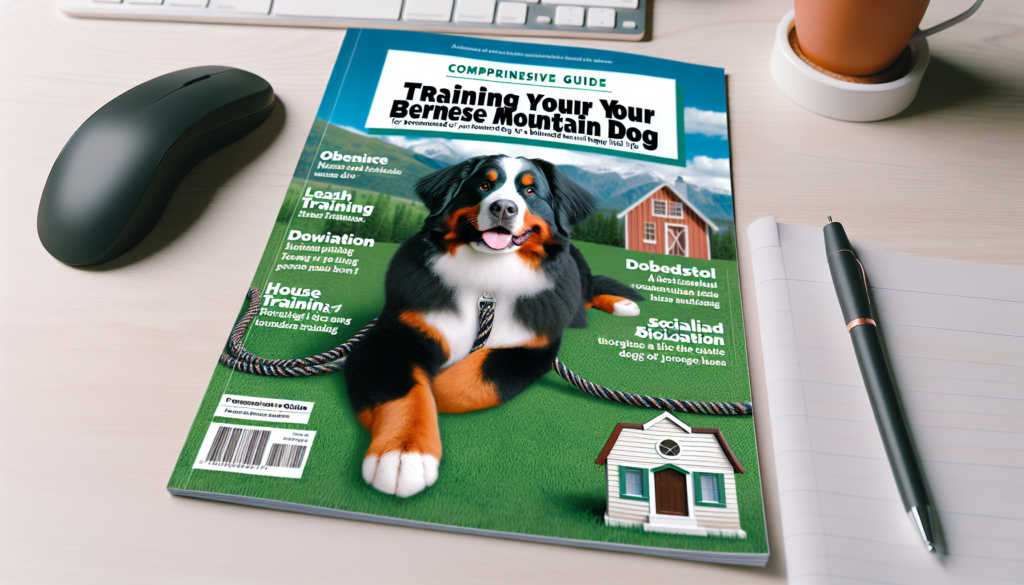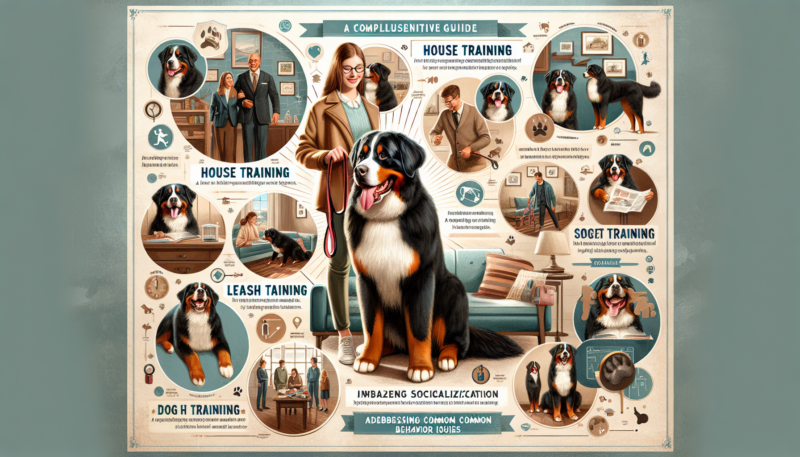So, you’ve decided to bring home a new furry friend and you’ve chosen a Bernese Mountain Dog. Congratulations! This captivating breed is not only stunningly beautiful, but also known for their friendly and gentle nature. However, just like any other dog, they require proper training to ensure they grow up to be well-behaved and obedient companions. In this article, we will provide you with a comprehensive guide on how to train your Bernese Mountain Dog, covering everything from basic obedience commands to socialization techniques. Get ready to embark on an exciting journey of bonding and training with your lovable Berner!
A Guide to Training a Bernese Mountain Dog

Choosing a Bernese Mountain Dog
When considering bringing a Bernese Mountain Dog into your family, it’s important to take certain factors into account. One of the most crucial aspects to consider is the dog’s health. Research the breed and familiarize yourself with any common health issues specific to Bernese Mountain Dogs. This will help you ensure that you choose a healthy dog and are prepared for any potential challenges that may arise.
Temperament and personality are also important factors to consider when choosing a Bernese Mountain Dog. These dogs are known for being gentle, loving, and friendly. They are great family pets and are especially good with children. However, like any other breed, individual dogs can have different temperaments. Spend time getting to know the dog before making a decision.
Choosing a reputable breeder is essential to ensure the health and wellbeing of your future Bernese Mountain Dog. A reputable breeder will prioritize the health and temperament of their dogs, providing you with a well-adjusted and healthy puppy. Do your research, ask for recommendations, and visit the breeder to see the conditions in which the dogs are kept.
Preparing for Training
Understanding the breed’s needs is key to successful training. Bernese Mountain Dogs are intelligent and willing to please, but they are also independent thinkers. They require mental stimulation and physical activity to prevent boredom and destructive behaviors. Ensure you are prepared to provide ample exercise and mental stimulation to keep your Bernese Mountain Dog happy and satisfied.
Gathering the necessary supplies before you begin training is important. Invest in a comfortable dog bed, food and water bowls, toys, and grooming supplies. Having these items ready will help your Bernese Mountain Dog settle into their new home and make training sessions more effective.
Creating a safe environment is essential for successful training sessions. Remove any potential hazards or items that could be easily damaged by your dog. Use baby gates or close doors to restrict access to certain areas until your Bernese Mountain Dog is fully trained. This will prevent any accidents or destructive behaviors while you focus on training.
Basic Training Commands
Training your Bernese Mountain Dog in basic commands is crucial for their safety and well-being. Start with the sit command, as it is one of the easiest to teach. Use treats and positive reinforcement to reward your dog for sitting on command. Gradually increase the duration of the sit until your dog can hold the position for longer periods.
The stay command is another fundamental command that should be taught early on. Begin by having your dog sit, then give the stay command while taking a step back. Reward your dog for staying in position and gradually increase the distance and duration of the stay.
Teaching your Bernese Mountain Dog to lie down on command is useful in various situations. Start with your dog in a sitting position, then lure them into the down position with a treat. Reward and praise your dog for lying down and gradually phase out the treat until they respond reliably to the command.
The come command is crucial for calling your Bernese Mountain Dog back to you, especially in potentially dangerous situations. Start by calling your dog’s name followed by the come command while crouching down and encouraging them with open arms. Reward your dog for coming to you and gradually increase the distance between you and your dog when practicing the command.
Positive Reinforcement Techniques
Using treats and rewards is one of the most effective positive reinforcement techniques for training a Bernese Mountain Dog. Keep small, soft treats handy during training sessions and reward your dog immediately after they perform the desired behavior correctly. This will help reinforce the behavior and motivate your dog to continue learning.
The clicker training method is another effective positive reinforcement technique. A clicker is a small device that makes a distinct clicking sound when pressed. Pair the clicker with treats and use it to mark the exact moment your dog performs the desired behavior correctly. This teaches your dog to associate the click with a reward and helps them understand which behavior is being reinforced.
Praise and affection are powerful tools when training a Bernese Mountain Dog. Dogs thrive on positive reinforcement, so be generous with your praise, petting, and belly rubs when your dog performs well during training sessions. This will strengthen the bond between you and your dog and make the training process enjoyable for both of you.

Socialization
Socialization is crucial for a well-rounded and confident Bernese Mountain Dog. Introduce your dog to other animals in a controlled and supervised environment. Allow them to interact with other friendly dogs, cats, and smaller pets. This will help prevent any aggressive or fearful behavior towards other animals in the future.
Meeting new people is also an important part of socialization. Introduce your Bernese Mountain Dog to a variety of individuals, including men, women, and children. Encourage gentle and positive interactions to help your dog develop positive associations with people of all ages and genders.
Expose your Bernese Mountain Dog to various environments to help them become comfortable in different situations. Take them on outings to parks, beaches, and busy streets. Introduce them to different sounds, smells, and sights. This will help them become more confident and adaptable in various environments, reducing the likelihood of anxious or fearful behavior.
Leash Training
Choosing the right leash is vital for leash training your Bernese Mountain Dog. Opt for a sturdy leash that allows you to maintain control while being comfortable for both you and your dog. A leash between four and six feet long is generally recommended for most training purposes.
Teaching loose leash walking is an essential skill for any dog. Start by walking with your dog on a loose leash and reward them for staying by your side. If your dog begins to pull, stop walking and wait for them to calm down before continuing. Consistency and positive reinforcement will help your dog learn to walk politely on a leash.
Addressing pulling behavior is crucial for enjoyable walks with your Bernese Mountain Dog. To discourage pulling, change direction whenever your dog pulls on the leash. This teaches them that pulling leads to a loss of forward progress.
House Training
Establishing a routine is key to successful house training. Set a regular feeding schedule for your Bernese Mountain Dog and take them outside to eliminate shortly after each meal. Consistency and patience are essential during this process.
Crate training can be a valuable tool when house training your Bernese Mountain Dog. Dogs naturally avoid soiling their den, so utilizing a crate can help prevent accidents inside the house. Gradually introduce your dog to the crate, making it a positive and comfortable space. Keep in mind that crate training should never involve leaving your dog confined for excessive periods.
Dealing with accidents is a normal part of house training. Act calmly when accidents occur, as punishment or scolding will only confuse your Bernese Mountain Dog. Clean up accidents promptly using an enzymatic cleaner to remove any lingering scent and discourage repeat accidents. Stay patient and consistent, and your dog will learn where they are allowed to go to the bathroom.
Obedience Training
In addition to basic commands, teaching commands like ‘leave it’ and ‘drop it’ can prevent your Bernese Mountain Dog from picking up dangerous objects or unwanted items. Use positive reinforcement and repetition to train these commands, rewarding your dog for complying with the cue.
Training for proper behavior in public is important for safety and enjoyment during outings. Focus on loose leash walking, responding to commands, and appropriate interaction with other people and animals. Gradually introduce distractions and reinforce desired behaviors in various public settings.
Discouraging jumping and excessive barking is crucial for a well-behaved Bernese Mountain Dog. Use positive reinforcement to reward your dog for keeping all four paws on the ground and remaining calm. Redirect their attention to an appropriate behavior, such as sitting, when they are tempted to bark excessively.
Exercise and Mental Stimulation
Meeting the daily exercise requirements of a Bernese Mountain Dog is essential for their physical and mental well-being. Aim for at least an hour of exercise each day, which can include brisk walks, jogging, hiking, or playing in a securely enclosed area. Adequate exercise will help prevent destructive behaviors and promote a healthy lifestyle.
Engaging in interactive games and puzzles is an excellent way to provide mental stimulation for your Bernese Mountain Dog. Hide treats in puzzle toys or play interactive games that encourage problem-solving. This will challenge their minds and prevent boredom, leading to a happier and well-rounded dog.
Training with agility equipment can provide both mental and physical exercise for your Bernese Mountain Dog. Set up simple agility courses in your backyard or attend agility classes. This type of training helps strengthen the bond between you and your dog while providing a fun and challenging activity.
Addressing Behavioral Issues
Separation anxiety is a common issue in Bernese Mountain Dogs, as they thrive on companionship. Gradually acclimate your dog to being alone by leaving them alone for short periods of time and gradually increasing the duration. Provide them with mental stimulation and comfort items, such as puzzle toys or a cozy bed, to alleviate anxiety.
Aggression towards other dogs can be problematic, especially during walks or visits to the dog park. Seek the help of a professional dog trainer or behaviorist to address this issue. Desensitization and counter-conditioning techniques may be necessary to help your Bernese Mountain Dog feel more comfortable and relaxed around other dogs.
Resource guarding is a behavior where dogs become possessive of items, such as food, toys, or even furniture. Work with a professional trainer to address resource guarding in a positive and safe manner. Utilize positive reinforcement and teach your dog to trade items willingly, ultimately reducing their possessive behavior.
Training a Bernese Mountain Dog requires time, consistency, and patience. Remember to keep training sessions fun and rewarding. A well-trained Bernese Mountain Dog will bring you years of joy and companionship, making all the effort worthwhile.
